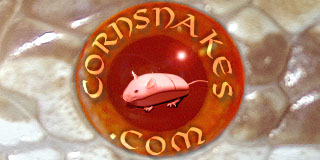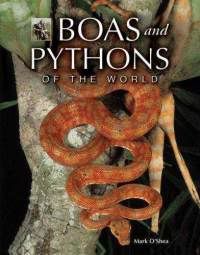TrpnBils
22 is not enough snakes
What I'd like to try to do is create a running list of reptile related books and reviews that forum members here might find interesting. I have 14 books in my collection...some of which I think are great and others I could do without. I'm hoping that by doing this I can get some other ideas for good reference manuals and such, so if you'd like to contribute, please answer the following:
1. Title/Author?
2. Basic overview/review of the book?
3. Was it worth your purchase?
So here's what I've got...
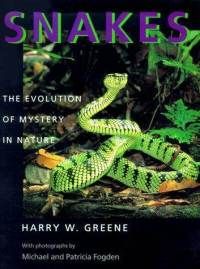
Snakes: The Evolution of Mystery in Nature (Harry W. Greene)
This is my absolute favorite reptile book that I own, but I could easily understand how it wouldn't be for everybody. It's a very technical book, and it reads more like a textbook than your everyday hobbyist reference manual. One of my favorite parts of the book is the thorough coverage of things like reptile anatomy and taxonomy. The photos are also pretty awesome! It covers the progression from the very primitive species to the advanced biology in modern venomous snakes. Although it does deal with evolution, it's not a preachy sort of book and sticks mainly to the biology of the matter. One oddball thing you don't normally find in other reptile books is a fairly heavy duty section on sea snakes.
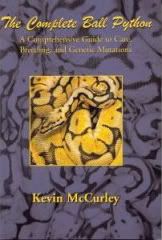
The Complete Ball Python (Kevin McCurley)
Exactly what it says. It's a great book for ball python keepers and covers their natural history better than many other sources that I've seen. The section on reproductive husbandry was especially useful for my wife and I when we started breeding ball pythons, and it details most of the steps in such a way that anyone could understand it. The morph list is relatively complete from what I understand (I don't really get into the real crazy morphs, so I'm sure there are some newer ones that aren't in there). One of my favorite parts to the morph section is the listing of where the original ones came from and who the original breeders are. There's something about keeping that record alive that I find kind of cool, because it's something that will eventually get lost in the trade anyway.

What's Wrong With My Snake? (John Rossi)
This is a decent book I guess, especially for new snake keepers, but I probably wouldn't buy it again if I lost my copy. It goes over basic health issues common to captive herps (upper RI's, scale rot, mouth rot, etc) and in some cases it offers up solutions that you can do at home to try to combat these issues. It's written by vets, but it's not a substitute for going to the vet if your pet runs into a problem. If you've been at the hobby for awhile, I probably wouldn't bother with this book, as you've probably seen much of this stuff at one point or another anyway. One very interesting thing I did take away from this book is a mathematical approach to feeding regimens for different body types. I don't know how accurate it is, but this is the only place I've ever seen anything like this.

Vivaria Designs (Jerry G. Walls)
Not a fantastic book in my opinion, but it's a good start for someone looking to go beyond the basics of newspaper substrate. I bought it when I was a reptile keeper at an AZA-accredited zoo because I thought it might spur some creativity for my vivarium designs. It has sections for all the common vivaria types (woodland, desert, etc), as well as beginner-related sections on the tools of herp keeping and how to make simple hides and water dishes. It's a decent starter manual for this sort of thing, but it's sort of the poor man's version of "The Art of Keeping Snakes" (see below). Overall, I don't feel like this was worth the purchase.
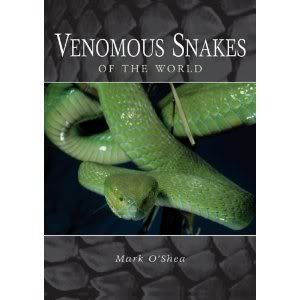
Venomous Snakes of the World (Mark O'Shea)
I was a little skeptical about how this book would be before I bought it because I tend to think of O'Shea as just a TV personality and not an author. As I don't keep any hot snakes, none of this really applies to me, but I wanted to learn more about some of the natural history and got this as a kind of piggyback purchase after I got another book by O'Shea and was impressed with it (see below). One of the most useful things that I got out of this book was a detailed look at the different types of venom and how they work on a biological level (which is something I've always been a little hazy about). If nothing else, the photos are really cool and since I don't know a whole lot about venomous snakes, there are a lot of interesting species that I don't know anything about. If I were to lose this book, I would probably replace it, but only if I could get it for cheap (used) like I did the first time.

Understanding Reptile Parasites (Roger Klingenberg)
One word: Gross. This book is a relatively detailed account of reptile parasites and their treatments. Something that really impressed me is how detailed the book gets. For example, it might cover a particular parasite, and then give you a list of species that are known to have been affected by them. The author covers all reptiles pretty well (most of the other books I own are particular to snakes, but this covers the whole spectrum of species). It also acts as a kind of medical reference on the treatment end of things, where it gives dosages and types of medicines known to eliminate the parasite. Also making an appearance are lists of symptoms and a ton of pictures... It's part of the same series of books that the "What's Wrong with My Snake" book is in, so it's got a similar setup. Again, it's written by a vet, but is no substitute for a visit if something does come up. It's definitely not a "sit down and read from start to finish" kind of book but it's a good reference.

The Art of Keeping Snakes (Philippe de Vosjoli
Awesome book. Again, because I was a zookeeper I had a lot of opportunity to create naturalistic setups for a variety of reptiles, and this particular book was a huge help in that endeavor. The author goes through a whole host of topics, such as designing the setup, creating the right soil mixture for certain types of environments, maintaining cleanliness within the enclosure (more difficult than in typical setups), and how to choose plants for the setup. Since this is in the same series as "Vivaria Designs" (see above), I don't know why they included both titles because this one is clearly the better of the two in my opinion.

The Reproductive Husbandry of Pythons and Boas (Richard Ross)
This book is published by the Institute for Herpetological Research in California, and as a result, it takes a very scientific approach to the breeding process. I had this book for quite awhile before I read it...I figured that since it was relatively old (1990 - old at least in comparison to where the hobby is today) that it might be outdated, but when I finally got around to reading it it was well worth it. I can't even begin to get into all that it covers, but I think it should be a must-read for any serious python or boa breeder, especially if you've experienced poor fecundity, high mortality rates, or other issues. Chances are, if it's ever been an issue, it's probably covered somewhere in this book. As with all of these books, get them used if you can. This book goes for like $75 in new condition and I got it for $5 because there was a small tear in the front cover (which I fixed with tape and it's perfectly fine now) and some wear on the pages.
1. Title/Author?
2. Basic overview/review of the book?
3. Was it worth your purchase?
So here's what I've got...

Snakes: The Evolution of Mystery in Nature (Harry W. Greene)
This is my absolute favorite reptile book that I own, but I could easily understand how it wouldn't be for everybody. It's a very technical book, and it reads more like a textbook than your everyday hobbyist reference manual. One of my favorite parts of the book is the thorough coverage of things like reptile anatomy and taxonomy. The photos are also pretty awesome! It covers the progression from the very primitive species to the advanced biology in modern venomous snakes. Although it does deal with evolution, it's not a preachy sort of book and sticks mainly to the biology of the matter. One oddball thing you don't normally find in other reptile books is a fairly heavy duty section on sea snakes.

The Complete Ball Python (Kevin McCurley)
Exactly what it says. It's a great book for ball python keepers and covers their natural history better than many other sources that I've seen. The section on reproductive husbandry was especially useful for my wife and I when we started breeding ball pythons, and it details most of the steps in such a way that anyone could understand it. The morph list is relatively complete from what I understand (I don't really get into the real crazy morphs, so I'm sure there are some newer ones that aren't in there). One of my favorite parts to the morph section is the listing of where the original ones came from and who the original breeders are. There's something about keeping that record alive that I find kind of cool, because it's something that will eventually get lost in the trade anyway.

What's Wrong With My Snake? (John Rossi)
This is a decent book I guess, especially for new snake keepers, but I probably wouldn't buy it again if I lost my copy. It goes over basic health issues common to captive herps (upper RI's, scale rot, mouth rot, etc) and in some cases it offers up solutions that you can do at home to try to combat these issues. It's written by vets, but it's not a substitute for going to the vet if your pet runs into a problem. If you've been at the hobby for awhile, I probably wouldn't bother with this book, as you've probably seen much of this stuff at one point or another anyway. One very interesting thing I did take away from this book is a mathematical approach to feeding regimens for different body types. I don't know how accurate it is, but this is the only place I've ever seen anything like this.

Vivaria Designs (Jerry G. Walls)
Not a fantastic book in my opinion, but it's a good start for someone looking to go beyond the basics of newspaper substrate. I bought it when I was a reptile keeper at an AZA-accredited zoo because I thought it might spur some creativity for my vivarium designs. It has sections for all the common vivaria types (woodland, desert, etc), as well as beginner-related sections on the tools of herp keeping and how to make simple hides and water dishes. It's a decent starter manual for this sort of thing, but it's sort of the poor man's version of "The Art of Keeping Snakes" (see below). Overall, I don't feel like this was worth the purchase.

Venomous Snakes of the World (Mark O'Shea)
I was a little skeptical about how this book would be before I bought it because I tend to think of O'Shea as just a TV personality and not an author. As I don't keep any hot snakes, none of this really applies to me, but I wanted to learn more about some of the natural history and got this as a kind of piggyback purchase after I got another book by O'Shea and was impressed with it (see below). One of the most useful things that I got out of this book was a detailed look at the different types of venom and how they work on a biological level (which is something I've always been a little hazy about). If nothing else, the photos are really cool and since I don't know a whole lot about venomous snakes, there are a lot of interesting species that I don't know anything about. If I were to lose this book, I would probably replace it, but only if I could get it for cheap (used) like I did the first time.

Understanding Reptile Parasites (Roger Klingenberg)
One word: Gross. This book is a relatively detailed account of reptile parasites and their treatments. Something that really impressed me is how detailed the book gets. For example, it might cover a particular parasite, and then give you a list of species that are known to have been affected by them. The author covers all reptiles pretty well (most of the other books I own are particular to snakes, but this covers the whole spectrum of species). It also acts as a kind of medical reference on the treatment end of things, where it gives dosages and types of medicines known to eliminate the parasite. Also making an appearance are lists of symptoms and a ton of pictures... It's part of the same series of books that the "What's Wrong with My Snake" book is in, so it's got a similar setup. Again, it's written by a vet, but is no substitute for a visit if something does come up. It's definitely not a "sit down and read from start to finish" kind of book but it's a good reference.

The Art of Keeping Snakes (Philippe de Vosjoli
Awesome book. Again, because I was a zookeeper I had a lot of opportunity to create naturalistic setups for a variety of reptiles, and this particular book was a huge help in that endeavor. The author goes through a whole host of topics, such as designing the setup, creating the right soil mixture for certain types of environments, maintaining cleanliness within the enclosure (more difficult than in typical setups), and how to choose plants for the setup. Since this is in the same series as "Vivaria Designs" (see above), I don't know why they included both titles because this one is clearly the better of the two in my opinion.

The Reproductive Husbandry of Pythons and Boas (Richard Ross)
This book is published by the Institute for Herpetological Research in California, and as a result, it takes a very scientific approach to the breeding process. I had this book for quite awhile before I read it...I figured that since it was relatively old (1990 - old at least in comparison to where the hobby is today) that it might be outdated, but when I finally got around to reading it it was well worth it. I can't even begin to get into all that it covers, but I think it should be a must-read for any serious python or boa breeder, especially if you've experienced poor fecundity, high mortality rates, or other issues. Chances are, if it's ever been an issue, it's probably covered somewhere in this book. As with all of these books, get them used if you can. This book goes for like $75 in new condition and I got it for $5 because there was a small tear in the front cover (which I fixed with tape and it's perfectly fine now) and some wear on the pages.
